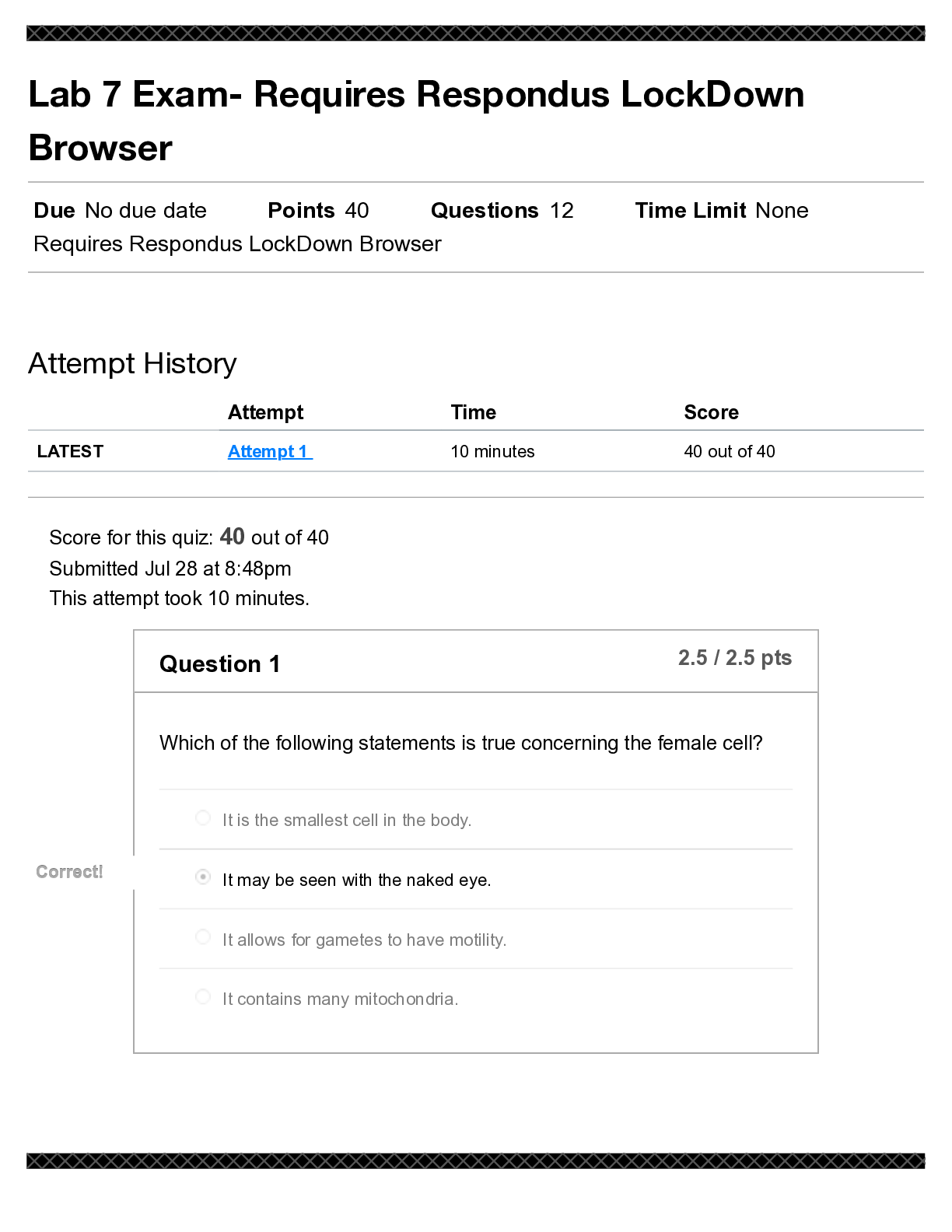Anatomy and Physiology - A&P 1 > LAB QUIZ > (SOLVED) BIOS 251 Week 1 Lab Assignment: Homeostatic Control: How does the human body keep itself in (All)
(SOLVED) BIOS 251 Week 1 Lab Assignment: Homeostatic Control: How does the human body keep itself in balance
Document Content and Description Below
OL Lab 1: Homeostatic Control: How does the human body keep itself in balance? Learning Objectives: • List some of the main physiological variables under homeostatic control • Employ appropriat... e vocabulary to discuss the processes and concepts of homeostasis • Explain the steps in a homeostatic pathway from stimulus to response • Compare different types of feedback loops • Identify signs of homeostatic disruption and determine the underlying mechanism Introduction: The human body is a very complex combination of finely-tuned machinery. Every organ system is dependent on the other to carry out its physiological functions along with maintaining an internal equilibrium. Homeostasis is the ability of the body to maintain an internal balance to in the body. So how does it always keep everything in balance? In this simulation, you will learn about the underlying regulatory workflow involved in the homeostatic process, through the examples of body temperature, blood pressure, and blood sugar regulation. Observe homeostasis in action You will test different settings on our virtual volunteer, Phineas. You will observe and analyze how the body reacts to the various stimuli such as changes in temperature, heart rate, and blood glucose levels in the body. Using a 3D model of the human body, you will be able to apply one or more stimuli on the test subject, to observe an immediate visible impact on physiological variables. From your observations, you will identify the sensors detecting the stimuli, the control center processing them, and the effectors acting to counter them on Phineas’ body. Finally, you will interpret the resulting changes in those variables to explain the homeostatic phenomenon. Part 1: Complete Labster Homeostatic Control Part 2: Report and Reflection Purpose: Describe in your own words and in complete sentences, the purpose of this experiment. The purpose of this experiment is to get a better understanding of how our body regulates homeostasis. Observations: List 2 observations you have made in this simulation. Our brain literally controls everything, more than I could ever imagine. The second observation was how are liver and panceas work together to help keep our sugar balanced. Answer all the questions below: 1. Why is it essential to have maintain homeostasis? (1 point) It is essential to maintain homeostasis because it helps our body adapt to our changing movements. We need homeostasis to prevent health issues 2. Provide an example of positive feedback mechanism and identify the stimuli, the central processing unit and the effectors involved in the pathway. (2 points) A positive feedback mechanism would be child labor. The stimulus would be when the baby is at the cervix. The hypothalamus is the control center. It releases the correct hormones needed for labor. An effector would be the contractions that are happening to help push the baby out. 3. In the simulation, what were the organs involved in homeostatic control? (2 points) The organs involved in homeostatic control are the brain, specifically the hypothalamus, your skin which would be the sensors and our blood vessels. 4. Using the figure below identify the abdominopelvic regions (5 points) 5. Reflection: Reflect on at least 2 key concepts you have learned from this simulation. How would you relate it to the physiological functions of the body? Two key concepts that I have learned is the body makes the necessary adjustments to our changing environment. The other concept would be how our body reacts to our sugar levels, either high or low. Kind of amazing. Grading Rubric: Activity Deliverable Points Part 1 Complete simulation 15 Part 2 Complete lab report and answer questions • Purpose (1 point) • Observation (2 points) • Questions (10 points) • Reflection (2 points) 15 Total Complete all lab activities 30 [Show More]
Last updated: 2 years ago
Preview 1 out of 5 pages

Buy this document to get the full access instantly
Instant Download Access after purchase
Buy NowInstant download
We Accept:

Reviews( 0 )
$12.00
Can't find what you want? Try our AI powered Search
Document information
Connected school, study & course
About the document
Uploaded On
Nov 04, 2022
Number of pages
5
Written in
Additional information
This document has been written for:
Uploaded
Nov 04, 2022
Downloads
0
Views
106


.png)


.png)


 (1).png)
.png)
.png)




